Physical Address
304 North Cardinal St.
Dorchester Center, MA 02124
![]() Access video lecture content for this chapter online at Elsevier eBooks+
Access video lecture content for this chapter online at Elsevier eBooks+
Craniomaxillofacial fractures are commonly encountered in plastic surgical practice. Fracture patterns vary widely ( Fig. 1.1 ) and may involve isolated facial bones, multiple contiguous bones, or multiple levels of the face with comminution or segmental bone loss.
Comprehensive assessment of the patient with facial injury by the trauma team is paramount. All patients with facial skeletal trauma should undergo initial assessment by a trauma provider (Emergency Medicine, Trauma/Acute Care Surgery, etc.). The primary evaluation should be in accordance with Advanced Trauma Life Support (ATLS) protocols ( Table 1.1 ).
| ATLS survey | Considerations in craniomaxillofacial injury |
|---|---|
| Airway | Facial swelling, trismus, oronasal bleeding, airway obstruction from mandibular fractures, aspiration of bone/tooth fragments |
| Breathing | Aspiration of bone/tooth fragments |
| Circulation | Oronasal hemorrhage, pseudoaneurysms of branches of external carotid artery, facial/scalp lacerations |
| Disability | Head injury, substance abuse, cranial nerve injury |
| Exposure/Environment | Facial piercings, dentures, contact lenses, glasses, hearing aids, orthodontic appliances |
Primary resuscitation maneuvers will focus on the ABCDEs: Airway, Breathing, Circulation, Disability, and Exposure/Environment. While formal craniomaxillofacial evaluation is a component of the secondary survey, management within each of these domains of the primary survey can be challenging in patients with facial injuries and there is an important role for the facial trauma specialist.
Patients with midface and/or mandibular fractures may present as challenging airways for several reasons. Facial swelling and trismus may limit one’s ability to evaluate the airway directly. Nasal or oral bleeding can similarly complicate visualization of the pertinent anatomy for endotracheal intubation. Avulsed teeth, dentures, or grossly loose bone fragments may pose an aspiration risk and should be removed. Specific facial fracture patterns may result in a propensity for airway obstruction, due to loss of skeletal support for soft-tissue structures such as the tongue base (e.g., patients with bilateral mandibular body fractures, Fig. 1.2 ). As with many craniomaxillofacial interventions, airway management remains a shared responsibility between the facial trauma surgeon and the anesthetist.
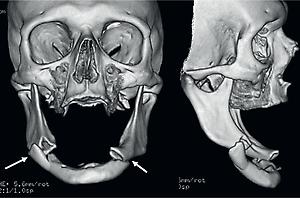
While initial decision-making for airway management should not be made based on the facial trauma repair plan (e.g., it is highly impractical to consider a nasal intubation in the acute trauma setting), the facial trauma surgeon and anesthetist will need to carefully consider airway management as a component of the operative plan in the future. Various options for airway management in the facial trauma patient are available ( Fig. 1.3 ) and the decision to pursue any specific intervention is predicated on a balance between the need to access specific structures (e.g., the dentoalveolar housing and occlusion), patient medical status and rehabilitation (e.g., patients needing prolonged ventilatory support may be best treated with a tracheostomy), and anesthetic provider familiarity with alternative airway management techniques (e.g., submental intubation or nasal fiberoptic intubation).

Patients with high-energy mechanisms of injury may have cardiopulmonary or intracranial injuries, both of which can impair spontaneous breathing. Aspirated tooth or bone fragments may end up within the lungs. In patients with avulsed teeth that have not been located, a chest radiograph is a necessary adjunct to determine whether there was pulmonary aspiration.
Historical approaches to management of craniomaxillofacial injuries relied on closed maneuvers to afford healing of the fractured segments. The use of external frame devices and splints was commonplace, based upon the belief that immobilization of the fractured segments would result in appropriate healing and function and that surgical exposure and manipulation would impair healing and, in young patients, disturb growth. This dogma was challenged in the 1980s, wherein the application of exposure techniques popularized in management of congenital craniomaxillofacial deformities allowed for improved access to the facial skeleton. In conjunction with these advances, surgeons gained a greater appreciation for the relationship of the facial soft tissues to the underlying skeletal framework and the need to address the soft tissue as a component of injury management. Immediate bone grafting and rigid fixation were seminal advances during this time period that changed the paradigm for facial trauma reconstruction. In the past two decades, the use of microvascular techniques and customized surgical planning for the management of facial injuries has improved the surgeon’s ability to address complex injuries in the acute setting. This natural evolution has reached an apex with the advent and increasing availability of craniomaxillofacial composite tissue allotransplantation for the treatment of severe secondary deformities from facial injury.
In conjunction with advances in the management of facial injuries, public health measures have changed the epidemiology of facial trauma. Improvements in vehicle design (e.g., crumple zones, improved rearview mirrors, automated collision monitors, improved windshield designs), restraints and air bags, as well as traffic regulations have decreased the frequency of severe injuries from high-energy motor vehicle collisions. The epidemiologic profile of other patterns of injury remains on the rise, however, with an increasing incidence of ballistic injuries due to the widespread availability of firearms, as well as a rise in facial injuries related to motorized scooters and bicycles.
The facial skeleton and associated soft tissues are highly vascularized and significant bleeding can occur from open lacerations or in the context of fractures ( Fig. 1.4 ). Management of acute bleeding from facial injuries includes temporary closure of wounds (e.g., scalp lacerations), nasal/oral packing, and operative exploration versus angioembolization for intractable hemorrhage from associated vascular injuries.

The Glasgow Coma Scale (GCS) is the most ubiquitous method of assessment of global function in the traumatized patient. Scores range from 3 to 15 and are based upon an assessment of responsiveness (eye opening and verbal communication) and motor function. Patients with facial trauma may have altered sensorium due to concomitant injuries (e.g., closed head injury), substance use (e.g., alcohol, illicit drug use), or medications administered as part of resuscitation (e.g., anesthetic agents or paralytics). Knowledge of the patient’s global functional level is critical for the facial trauma surgeon, as the secondary survey assessment of craniomaxillofacial injuries requires close contact with the patient and, for many maneuvers, such as assessment of motor and sensory nerve function, responsiveness and ability to follow commands.
Most patients evaluated by the facial trauma surgeon in the acute or subacute setting will be seen within medical facilities. The patient’s environment/exposure in this context may pertain to facial devices that should be removed to facilitate resuscitation and evaluation. These include contact lenses, dentures, hearing aids, and facial piercings.
An additional component of the patient’s environment to consider is the high incidence of facial injuries related to intimate partner violence (IPV). A simple screening tool for assessing IPV is the Partner Violence Screen (PVS, Box 1.1 ). An affirmative response to any of these questions should trigger further evaluation for IPV, including an assessment by social work and abuse specialists.
Have you been hit, kicked, punched, or otherwise hurt by someone within the past year? If so, by whom?
Do you feel safe in your current relationship?
Is there a partner from a previous relationship who is making you feel unsfafe now?
A focused head and neck evaluation remains the main component of the secondary survey for the facial trauma surgeon. This assessment is established with a careful history, including a focus on the mechanism of injury, presence of concomitant extra-craniomaxillofacial injuries that may affect the exam findings and/or management, and medical history pertinent to management, including the use of anticoagulant medications and a history of dental or orthodontic treatment or facial reconstructive surgery.
A thorough examination of the head and neck is necessary for all patients with facial injuries, regardless of the severity of the visible injury. The visible soft-tissue injury may not predict the magnitude of the skeletal injury and vice versa ( Fig. 1.5 ). There are several methods used to systematically evaluate the head and face – top to bottom, bottom to top, inside-out, etc. No single approach is superior – the critical principle is that the evaluation must be performed in a consistent and systematic manner such that no injury is missed.
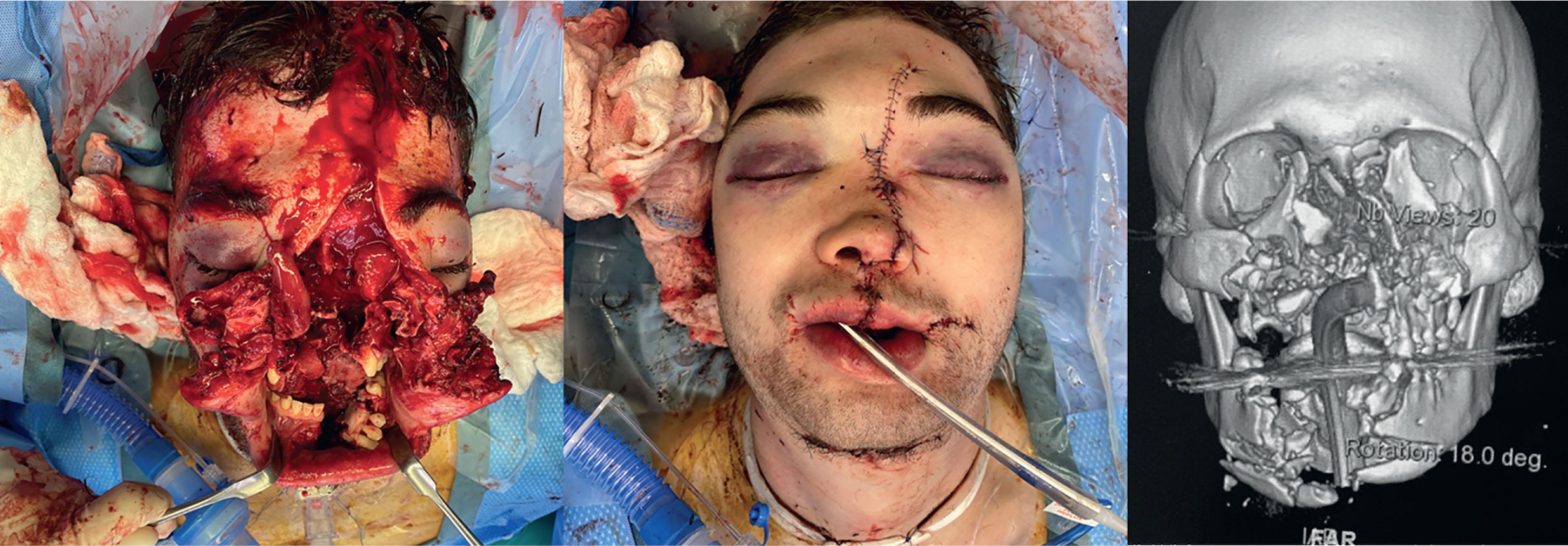
Clinical examination of the head and neck in the facial trauma patient begins with a global assessment of the soft tissues. The clinician should meticulously examine the scalp, face, and neck looking for abrasions, contusions, swellings, bruising, or lacerations. Undiagnosed scalp or intraoral injuries can be a significant contributing factor for blood loss (see Fig. 1.4 ). Patterns of ecchymoses may portend underlying facial skeletal injury – bilateral periorbital ecchymoses (“raccoon eyes”, Fig. 1.4B ) has been considered indicative of naso-orbito-ethmoid (NOE) fractures, sublingual ecchymoses may be seen in patients with mandibular fractures, palatal ecchymoses may be associated with Le Fort fractures (Guerin’s sign), and skull base fractures may present with post-auricular ecchymoses (Battle’s sign).
Focused examination of the skeletal framework and associated structures (eyes, ears, nasal passages, dentition) follows this initial assessment of the external soft-tissue drape. The clinician should assess for symmetry of the facial skeleton, inspecting one side of the face and comparing to another. The presence of asymmetry may be related to soft-tissue swelling, skeletal displacement, or both. Palpation of the facial skeleton follows, with the examiner assessing for step-offs along the bony surfaces point tenderness to palpation, or gross mobility of bony segments.
The authors’ preferred approach is a “top-down” assessment, wherein the forehead and supraorbital rims are assessed for contour deformity and step-offs. This is followed by palpation of the external orbital framework along the frontozygomatic pillar and infraorbital rim, extending to the nasofrontal junction. Evaluation of the zygomas should assess for projection, width, and zygomatic arch morphology. Nasal assessment should include inspection for dorsal nasal deviation followed by palpation of the bony pyramid, as well as an intranasal evaluation to assess the position of the nasal septum, patency of the nasal airway, and the presence of intranasal bleeding/hematomas. The maxilla should be evaluated for mobility at the Le Fort I, II, and III levels. An intraoral examination is critical to assess for dental trauma, including missing or fractured teeth, mobile alveolar segments, and intraoral bleeding/lacerations. The integrity of the salivary duct orifices should be assessed, particularly in patients with penetrating facial lacerations involving the cheek ( Fig. 1.6A ). The maxillary and mandibular dental arches should be assessed for their integrity. Evaluation of the occlusion should focus on the consistency of interdigitation of the teeth – the presence of open bites, crossbites, or premature contacts should be noted. Alignment of dental wear facets ( Fig. 1.6B ) and the presence of mammelons ( Fig. 1.6C ) on the incisors can provide clues as to a patient’s baseline occlusal relationships. The mandible is assessed for mouth opening (>40 mm), congruity of the inferior border, and deviation with movement.
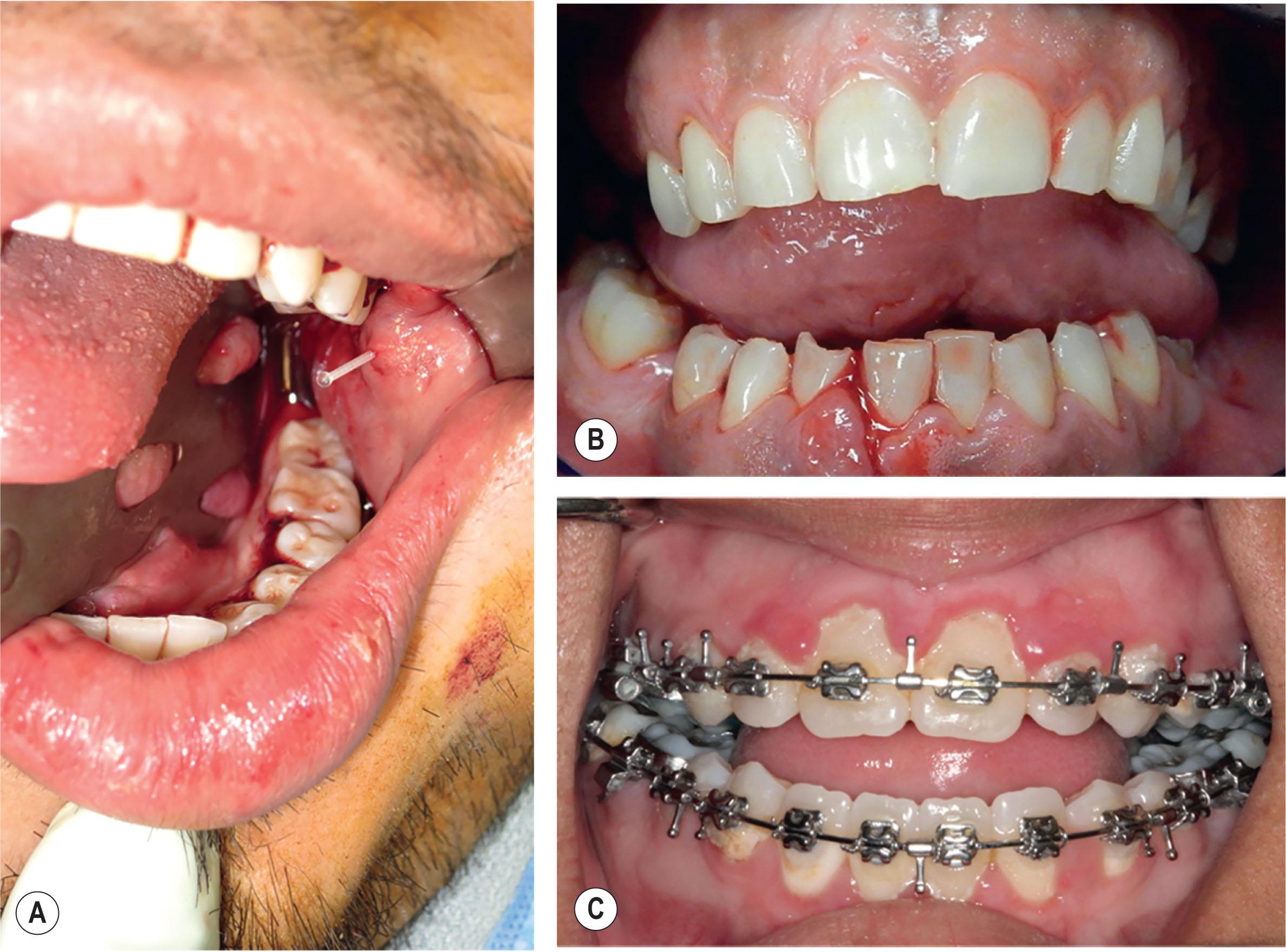
The clinical evaluation is completed by an assessment of neurosensory and motor functions. The distributions of the trigeminal nerve (V 1 – supraorbital, V 2 infraorbital, and V 3 – mandibular) should be assessed for hypoesthesia or anesthesia. Decreased sensibility along these distributions is frequently suggestive of displaced fractures in proximity to the course of these nerves. Similarly, facial lacerations may interrupt cutaneous innervation to the various regions of the face. Assessment of facial movement is critical to evaluate for the presence of facial nerve (cranial nerve VII) injury.
Examination of the eyes is a critical component of the facial trauma evaluation. Coordinated, voluntary movement of the eyes requires the function of cranial nerves III, IV, and VI. Extraocular muscle dysfunction may be due to nerve injury/compression, as seen in superior orbital fissure (SOF) and orbital apex (OAS) syndromes, or from mechanical restriction, as seen in orbital floor fractures with entrapment ( Fig. 1.7A ). In patients with SOF syndrome, the affected cranial nerves will result in ophthalmoplegia (cranial nerves III, IV, and VI) as well as corneal anesthesia (cranial nerve V 1 ). If there are visual acuity changes due to injury to cranial nerve II, in addition to ophthalmoplegia and corneal anesthesia, a diagnosis of OAS is made. Pupillary size and symmetry, reactivity, globe position, globe tension, and visual acuity should be directly assessed. Globe integrity, vitreous or scleral hemorrhage should be documented ( Fig. 1.7B–D ). Ophthalmologic assessment is necessary in patients with orbital fractures and those with evidence of ocular injury.
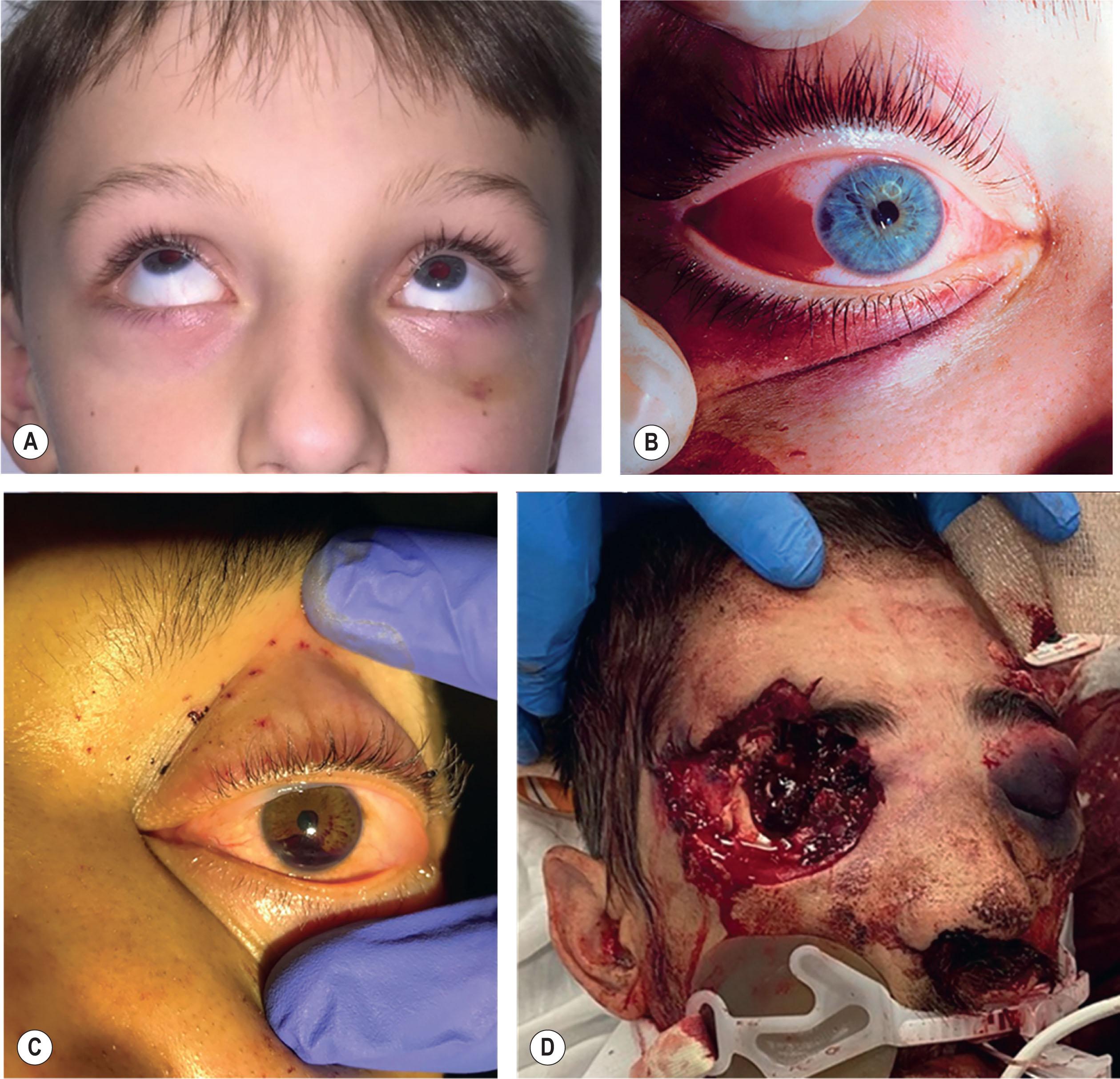
A number of imaging modalities may be used in patients for evaluation of patients with facial injuries ( Fig. 1.8 ). High-resolution, multi-detector computed tomography (CT) scans are the standard for evaluation of facial skeletal injuries. Images should be acquired with axial, coronal, and sagittal reformations, with both bone and soft-tissue windows. Three-dimensional (3D) reformations are useful for assessment of symmetry and orbital volume. Specialized imaging protocols, such as CT angiography and orbital apex views, may be useful in specific clinical situations.
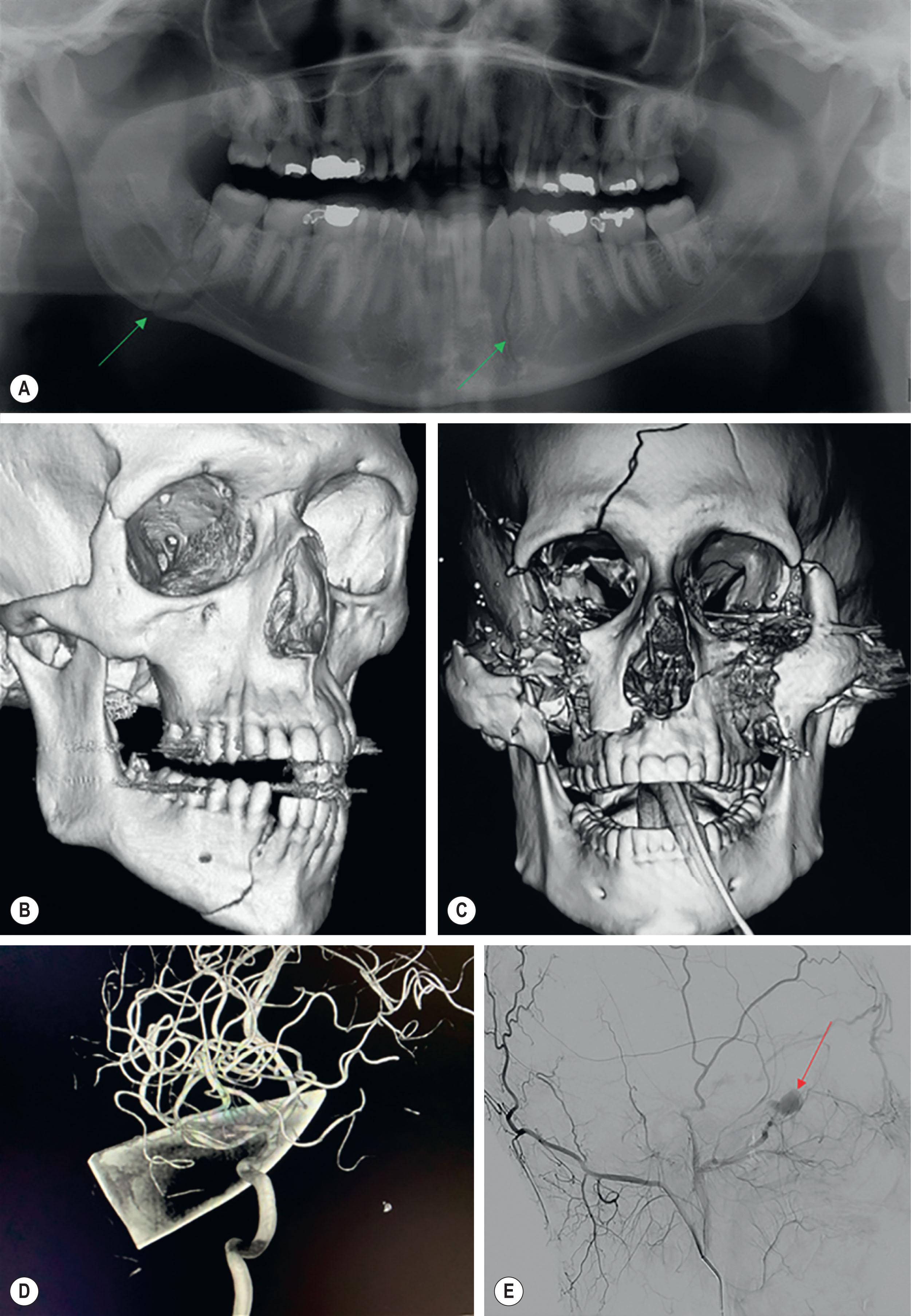
There remains considerable debate regarding the optimal timing for management of facial injuries. It is the authors’ general opinion that management of facial bone and soft-tissue injuries should be undertaken as soon as the patient’s general condition allows, but generally within 1 week of injury. Immediate management carries the advantage of accurate repositioning of the skeletal framework prior to the onset of soft-tissue swelling. The waxing and waning facial soft-tissue swelling that accompanies delayed management (initial swelling from the injury is allowed to recede and recurrent swelling develops following subsequent intervention) may contribute to fibrosis and end-stage deformities, which can be difficult to fully correct. The need to achieve optimal results in this context must be balanced with the patient’s global burden of injury, as facial fractures are not surgical emergencies. In patients with significant multisystem injuries who may not be medically stable for extensive open reduction and internal fixation procedures, management of soft-tissue lacerations, placement of interdental fixation, reduction of grossly displaced fractures, and repair of critical structures such as nerves or the parotid duct can and should be undertaken in the acute period.
The general principles of facial fracture management ( Box 1.2 ) are centered around: (1) accurate diagnosis based on history, exam, and imaging; (2) appropriate exposure of fractured segments; (3) reduction of fractured bones into their anatomic position, with the use of autologous grafts to reinforce and/or reconstruct compromised buttresses; (4) application of rigid fixation to allow bony union; and (5) resuspension/reconstitution of the overlying soft-tissue envelope.
Accurate diagnosis: Careful history, clinical examination, and appropriate imaging
Exposure of fractured segments
Reduction of fractured skeletal components, with use of autologous bone grafts to reconstruct compromised buttresses
Application of rigid fixation to allow bony union
Resuspension/reconstitution of affected soft tissues
The necessity for accurate diagnosis cannot be underestimated. Systematic assessment of the patient and imaging is mandatory to develop a treatment plan that effectively addresses all injuries. Specific patterns of injuries should be recognized, as management of one injury type is predicated on appropriate management of the other. For example, failure to recognize the presence of a NOE fracture in a patient with a zygomaticomaxillary complex fracture will result in inadequate reconstruction of the midface and a secondary deformity that is difficult, if not impossible, to fully correct.
Exposure of the fractured segments should be a balance between affording adequate visualization of the fracture and avoiding extensive soft-tissue degloving and periosteal stripping of bony segments. A wide variety of approaches exist for accessing various parts of the facial skeleton. The facial trauma surgeon should be familiar with surgical approaches to the upper face, orbit, midface, and mandible ( Fig. 1.9 ). Each approach has benefits and limitations – it is critical that the facial trauma surgeon should have comfort with a surgical approach that affords access to the region of interest while minimizing damage to nerves and providing acceptable scarring.
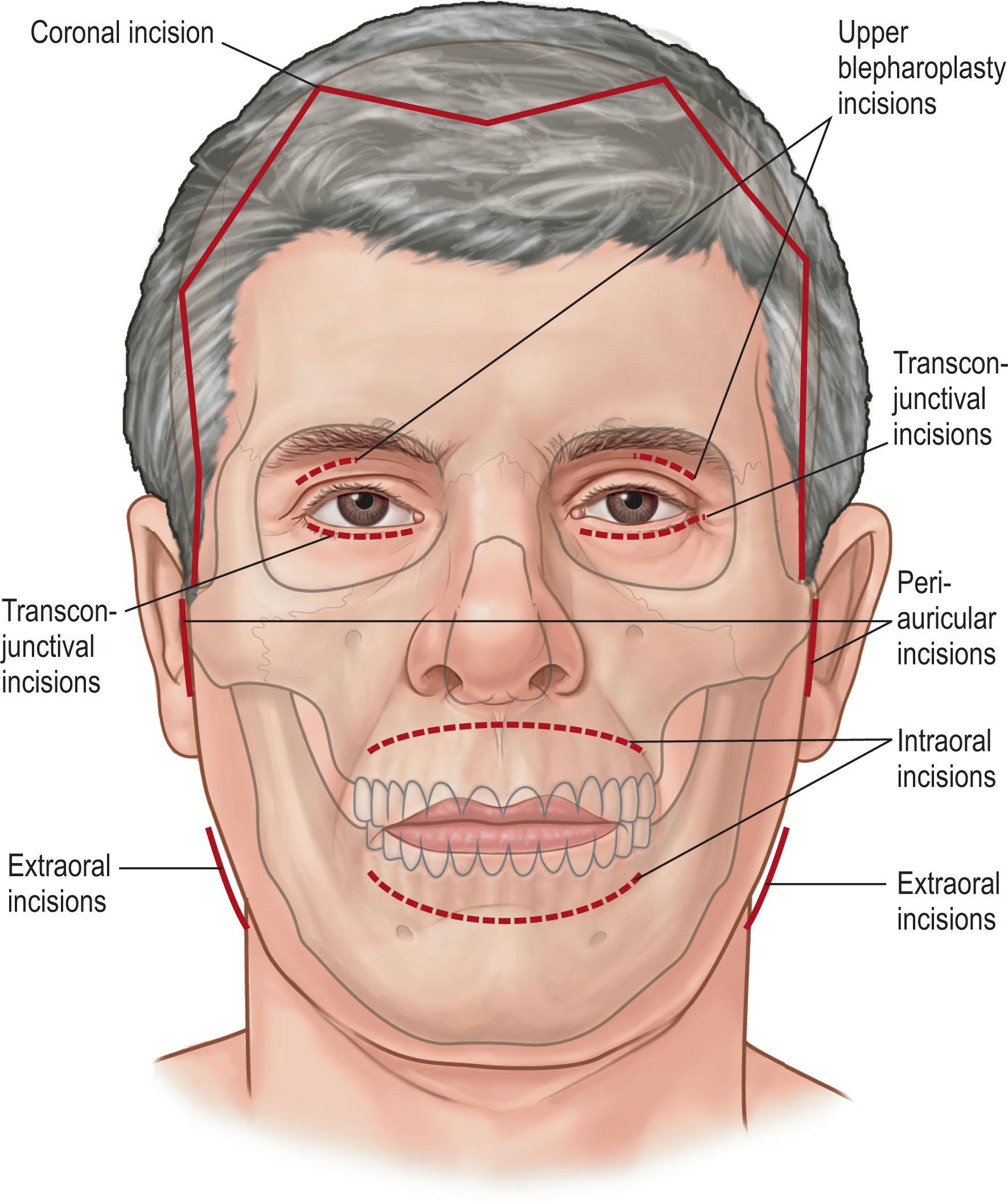
Once exposure is achieved, reduction of the fractured segments into anatomic alignment is necessary. A common critical error is to expose the fracture and apply fixation without an appropriate reduction (colloquially termed an “open internal fixation”). Failure to recognize an inadequate reduction will likely result in a secondary deformity that may be difficult to address. The surgeon should have familiarity with the facial skeletal buttresses ( Fig. 1.10A ), as these areas represent the impact distribution points of the facial skeleton and need to be adequately reconstructed to support the skeleton and overlying soft tissues. In clinical circumstances where anatomic repositioning results in significant bony gaps (>2 mm), autologous bone grafting should be strongly considered to reinforce the buttresses.
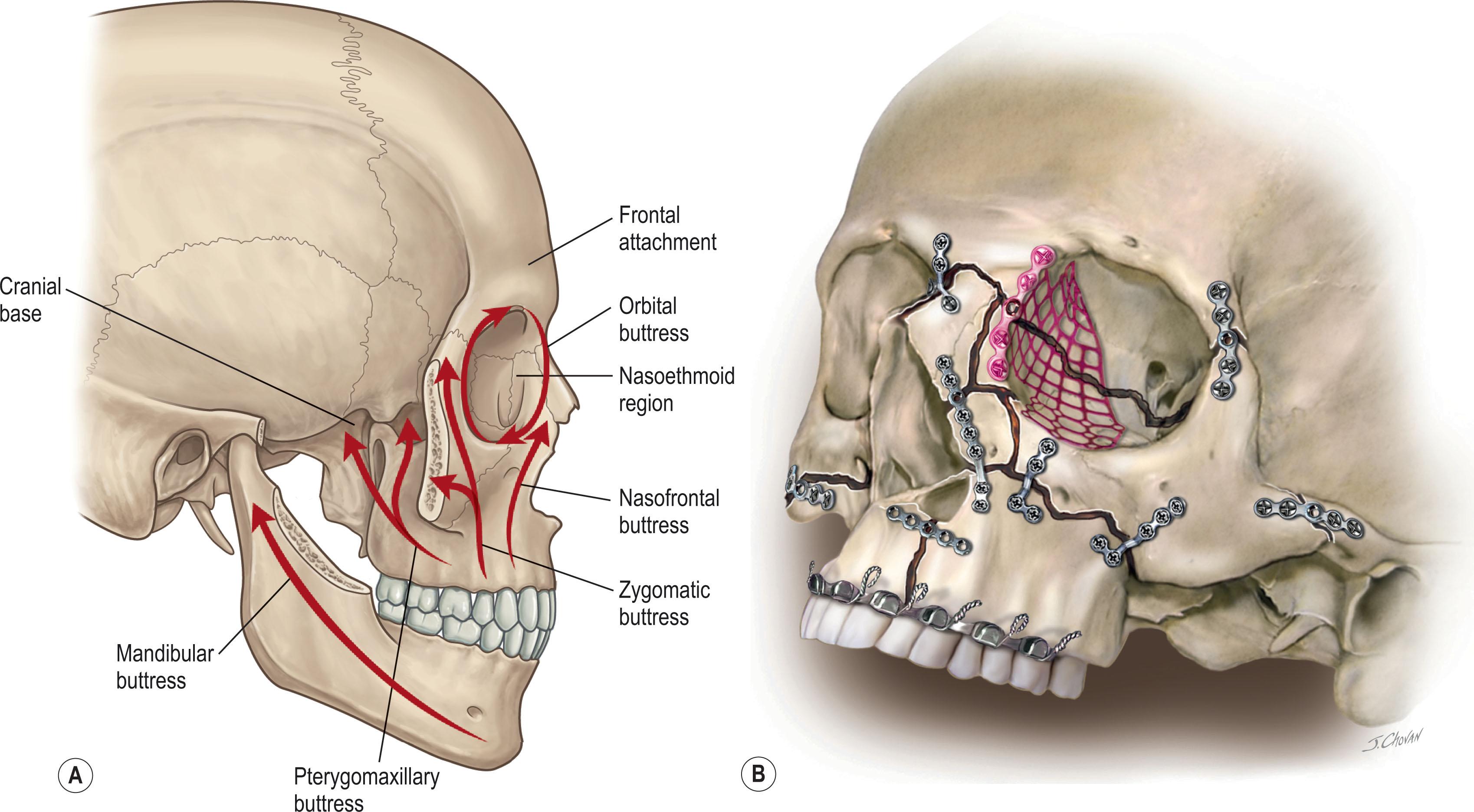
Following anatomic reduction, application of appropriate fixation is necessary to stabilize the segments. Fixation should be applied across the fractured buttresses ( Fig. 1.10B ), with plates adapted to fit passively along the reduced fracture segments. Generally, rigid fixation within the facial skeleton is sufficient to prevent displacement of fractured segments with low-intensity activities. Requirements for rigid fixation will differ based upon the region of the facial skeleton. In regions with low functional loading requirements, such as the upper face/orbit/NOE complex, thinner plates may be sufficient. Moderate functional loading, as seen with occlusal forces on the maxilla or masseter muscle force on the zygoma, necessitates placement of heavier plates. Rigid fixation of the mandible requires devices that will resist muscle pull and masticatory forces. With rare exceptions, internal fixation of the facial skeleton is not sufficient to prevent displacement from high-intensity activities, such as contact sports or, in the case of fractures affecting the occlusion, mastication. In this context, patients should be counseled about the need to be on modified diets and delay in return to contact sports until bony union is achieved. The authors’ general protocol following rigid fixation is to abstain from contact sports (or similar activities) for 3 months following injury. In patients with injuries affecting the occlusion, a soft, non-chew diet is prescribed for 6 weeks after fracture reduction.
Soft tissue resuspension and bolstering should occur following anatomic reduction and application of rigid fixation to ensure appropriate re-draping and adaptation of the overlying soft tissues. Maneuvers such as mid-face resuspension, medial canthal bolsters, and external nasal splints are critical adjuncts that should not be overlooked at the completion of skeletal fixation.
The frontal sinuses are paired, aerated cavities lined with ciliated respiratory epithelium with associated mucus glands. These sinuses develop in the postnatal period and are first visible at 3 years of age. Sizable pneumatic expansion occurs at 7–8 years of age and full development is complete by age 20. Mucus-secreting glands within the sinus perform an immune function and the ciliated epithelium maintains the circulation of mucin toward the nasofrontal outflow tracts (NFOT). When the frontal sinus or anterior skull base is injured, the NFOTs are at risk for obstruction, mucinous flow is impaired and the risk for infection and mucocele formation increases.
The most common form of injury to the frontal sinus is fracture, occurring in up to 12% of all cranial fractures and in up to 2% of patients with cranial or cerebral trauma. The most common pattern is involvement of the anterior and posterior tables and/or ducts of the sinus (60%), followed by involvement of the anterior table alone (30%). Isolated posterior table fractures are relatively rare (<10%). Approximately 40% of frontal sinus fractures have an associated dural injury, which increases the risk of cerebrospinal fluid leak and infection, due to a direct path of communication between the nasal cavity and intradural space.
Lacerations, hematomas, and ecchymoses/contusions are frequently seen in patients with frontal bone or frontal sinus injuries. Decreased sensation in the distribution of the supraorbital nerve may be seen. In patients with associated dural injury, cerebrospinal fluid leak may be clinically evident as rhinorrhea. The halo test is a rudimentary assessment tool for CSF rhinorrhea – when nasal secretions are isolated on gauze, the different density of CSF relative to blood will result in a “halo” of CSF around a central ring of blood ( Fig. 1.11 ). When clinical suspicion for a CSF leak is high, secretions should be sent for beta-2-transferrin testing.
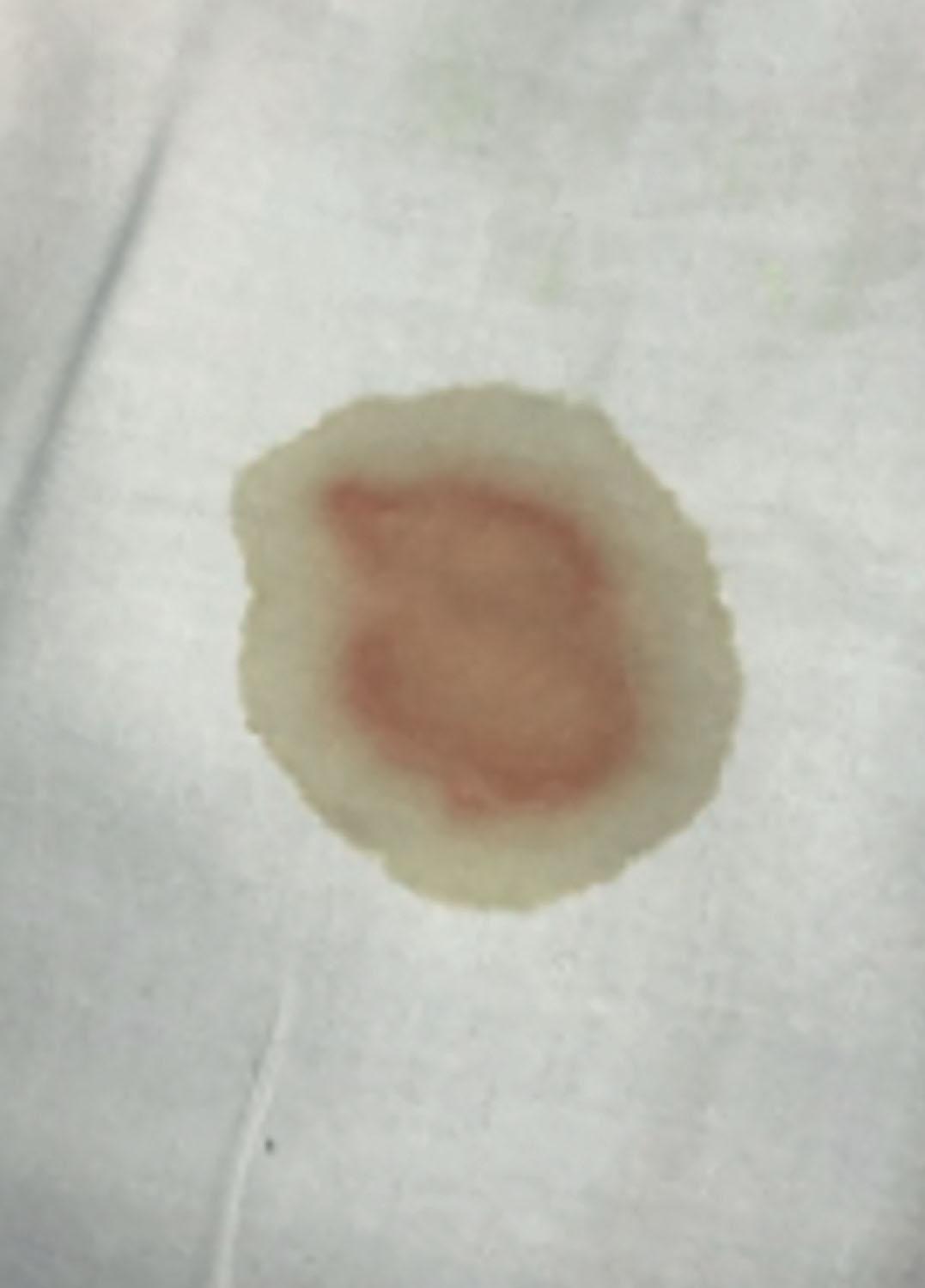
The floor of the frontal sinus laterally is the roof of the orbit – patients with frontal sinus injuries frequently have periorbital ecchymoses, subconjunctival hemorrhage, as well as intra-orbital emphysema. Displacement of the anterior table may result in clinically evident contour deformity, but this is frequently not immediately apparent, due to post-injury swelling.
In some instances, particularly small or non-displaced fractures, injury to the frontal sinus may be difficult to detect. The first presentation in this context may be infection or symptom of NFOT obstruction, such as mucocele or abscess formation. Such pathology can have serious consequences, due to the proximity of the frontal sinus to the meninges and parenchyma. Infectious complications associated with frontal sinus injuries may include meningitis, intracranial abscess (extradural or intradural), or bony infections (osteitis or osteomyelitis). Management of infectious complications in this region can be a significant undertaking, recognition of the potential for serious sequelae and appropriate initial management is key.
The importance of the nasofrontal outflow drainage system is central to management of frontal sinus injuries. The nasofrontal outflow tract (NFOT) is a connection between the frontal sinus to the nasal cavity, from the foramina of Breschet within the sinus floor, via the anterior ethmoidal air cells, and exiting through the ethmoidal infundibulum adjacent to the middle turbinate. The NFOT is involved in up to 50% of frontal sinus fractures; obstruction of the NFOT results in inadequate drainage of normal mucosal secretions, which may result in the formation of obstructive cysts. When islands of mucosa become trapped within the fracture, subsequent mucosal growth may result in a mucocele. Of note, the average interval between primary injury and mucocele development is 7–8 years, underlying the importance of long-term follow-up of patients with frontal sinus injuries.
Management of obstructed NFOTs in the context of frontal sinus fractures may require obliteration of the sinus. This involves complete removal of the sinus lining and elimination of the foramina.
Frontal bone and sinus fractures are readily visualized on computed tomographic scans. The presence of fluid within the sinus may suggest obstruction of the NFOT, as do displaced fractures within the medial floor of the sinus, near the foramina. With regular respiration and patent NFOTs, the sinuses will aerate over time. Persistent air–fluid levels within the sinus suggest inadequate NFOT function. When there is doubt regarding the patency of the NFOT, one can consider repeat imaging (plain film or CT) 5–7 days after the injury to assess for aeration of the sinuses.
Fractures of the frontal bone and sinus are classified according to the anatomic location (anterior table, posterior table, or both) and displacement (non-displaced or displaced). Indications for surgical intervention are varied but include: depression of the anterior table with associated or anticipated contour defect, radiographic demonstration of NFOT obstruction (occlusion of the NFOT on imaging or evidence of persistent air-fluid levels on serial imaging), posterior table injury with associated cerebrospinal fluid leak, and mucocele formation. There remains controversy regarding management of non-displaced fractures of the posterior table, with some advocating for mandatory exploration and others advocating for exploration only in the setting of significant displacement (e.g., >50% of posterior table thickness). There is consensus that non-displaced, linear fractures of the anterior and posterior tables can be managed non-surgically.
Fractures of the frontal bone and sinus are most appropriately approached via a coronal incision. The coronal incision allows for a well-hidden scar while also affording access to the anterior cranial fossa and development of a pericranial flap ( Fig. 1.12 ).

In patients with depressed anterior table fractures without NFOT obstruction, reconstruction of the frontal bone contour to the premorbid state is the goal ( Fig. 1.13 ). The anterior table fragments are elevated into anatomic alignment and fixated using miniplates. In patients with anterior table fractures and NFOT obstruction, the outflow tract will need to be managed. This will require removal of the anterior table, complete extirpation of the sinus lining, and obliteration of the outflow tracts ( Fig. 1.14 , top). Obliteration of the outflow tracts can be accomplished with a wide variety of tissue materials; the authors’ preference is to use particulate calvarial bone. The sinus cavity can then be filled with bone graft, either particulate calvarial graft or cancellous iliac crest; obliteration of the outflow tract without management of the sinus cavity may lead to a higher incidence of infection and mucocele formation.
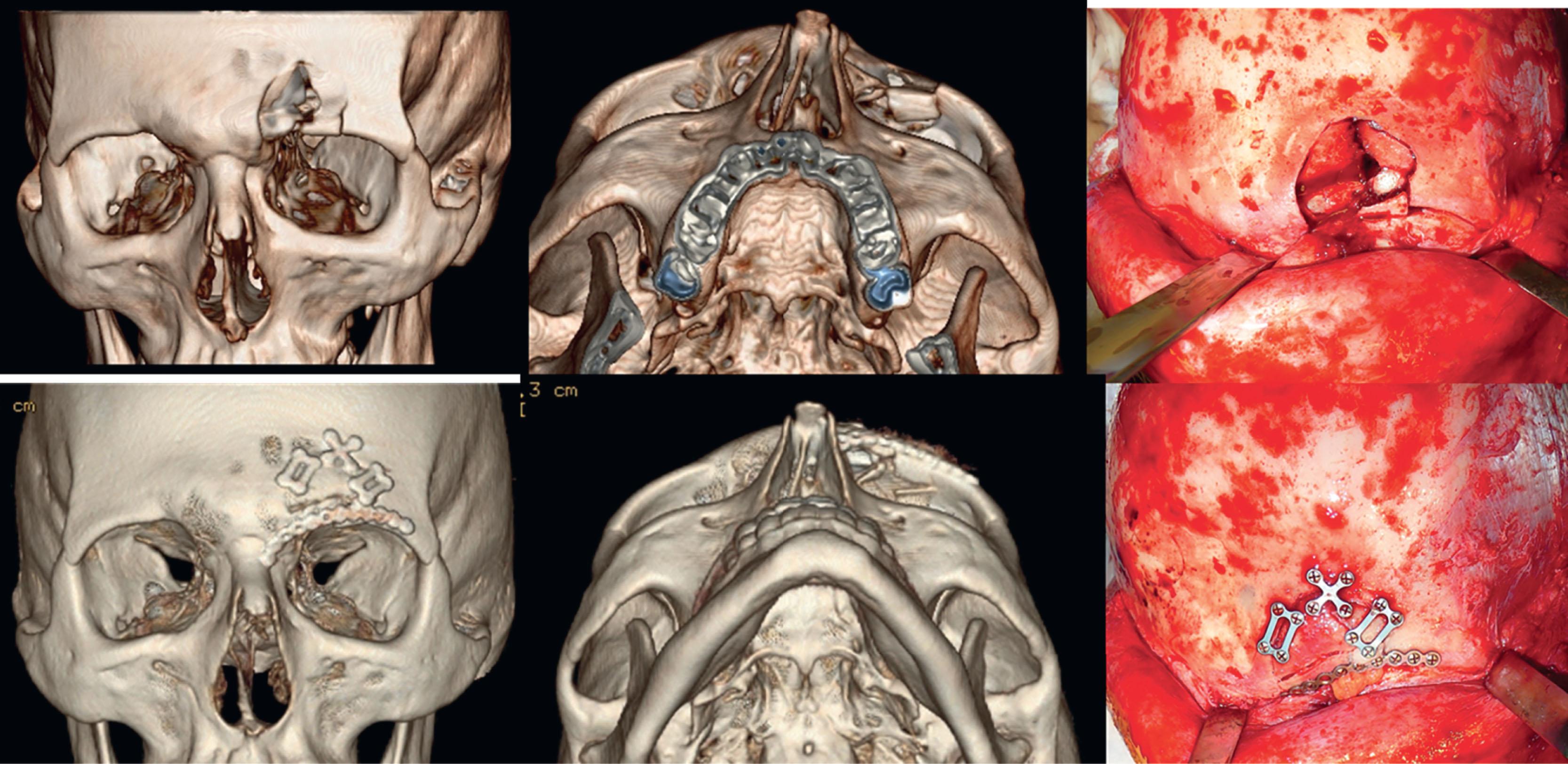

Patients with displaced posterior table injuries require more extensive surgical management ( Fig. 1.14 , bottom). A critical principle in management of these types of injuries is recognition that the posterior table and anterior cranial base are contiguous structures. If the posterior table is significantly damaged and/or missing, cortical bone grafts are needed to reconstruct the floor of the anterior cranial fossa. The sinus is then obliterated in the same manner as for anterior table fractures with NFOT obstruction. The para-sagittal and lateral portions of the anterior cranial base are contiguous with the orbital roof; bony defects in these regions should be reconstructed with cortical bone graft to prevent late complications from dura in apposition to periorbita (e.g., pulsatile exophthalmos). Pericranial flaps, which may be based anteriorly (supraorbital or supratrochlear systems), laterally (temporal system) or posteriorly (occipital system) are utilized to provide vascularized lining to the obliterated endocranial dead space.
Minor complications associated with frontal bone or sinus fractures include contour defects. Contour defects in the frontal bone may be addressed with autologous fat grafting or subsequent cranioplasty. When considering reconstruction of secondary deformities in this region, the surgeon should carefully consider the integrity of the frontal sinus. Communication between the frontal sinus and overlying forehead soft tissue may increase the likelihood of infection with the use of alloplastic materials for contour correction.
Major complications associated with frontal bone and sinus fractures include CSF rhinorrhea, orbital emphysema, pulsatile exophthalmos, and carotid-cavernous fistula. Management of these major sequelae typically requires a multidisciplinary approach; prevention is the best strategy.
The orbits are conical structures that are comprised of multiple bony fusions. The orbital framework is composed of the frontal, zygomatic, maxillary, palatine, ethmoid, sphenoid, and lacrimal bones ( Fig. 1.15 ). Anatomically, the orbit can be conceptualized in thirds, from anterior to posterior. The anterior third consists of the external orbital framework and is composed of thick bone related to regional facial buttresses. The middle third of the orbit is largely comprised of thin bone along the orbital floor and medial wall (lamina papyracea). The posterior third of the orbit contains bony foramina that allow the transit of neurovascular structures, with associated thickening of the bone. The superior orbital fissure and orbital apex are located within the posterior–medial orbit. The superior orbital fissure transmits cranial nerves III, IV, V 1 , and VI, along with the superior ophthalmic vein. The optic foramen, situated at the posterior junction of the lateral and medial orbital walls, transmits the ophthalmic artery and optic nerve (cranial nerve II). The optic foramen is typically located 40–45 mm posterior to the infraorbital rim.

This anatomical arrangement results in a “shock-absorbing” response to impact. Energy transmitted to the anterior orbit is absorbed by the thick bony framework of the external orbit. Residual energy that is not captured by the external framework is then transmitted to the middle of the orbit, where the thin bone fractures, dissipating the force and preventing globe rupture and injury to the posterior orbit, where critical neurovascular structures reside.
Physical examination of the patient with orbital injury requires careful assessment of the bony framework as well as eye and ocular adnexa (see Fig. 1.7 ). The most critical component of evaluation in any patient with a fracture involving the orbit is assessment of visual acuity. Visual acuity should be tested in each eye and may be simply done by asking the patient to read print or identify letters on a standard ophthalmologic exam card. Visual field examinations are necessary to identify limitations in extraocular movement and changes in visual acuity (i.e., diplopia) with movement (see Fig. 1.7A ). All patients with orbital injuries should have pupillary size and reaction evaluated during the initial assessment (as well as postoperatively). Absence of light perception is indicative of optic nerve injury or globe rupture. Light perception without usable vision may suggest optic nerve damage, retinal detachment, anterior (hyphema) or posterior chamber hemorrhage, or vitreous hemorrhage. Intraocular pressures may be assessed using tonometry, with pressures <15 mmHg considered normal. Ophthalmologic consultation is mandated for all patients with globe or eye injuries.
Three-dimensional visualization of the orbit is necessary to accurately diagnose and manage orbital fractures. Axial views may demonstrate air–fluid levels within the maxillary sinus which, in the absence of other midface skeletal injury, are strongly suggestive of orbital injury. Coronal and sagittal views are commonly utilized in conjunction for assessing the size and displacement of orbital floor and roof fractures. Concurrent visualization of coronal and axial views is similarly valuable for the characterization of medial wall and lateral wall fractures. The clinician should evaluate both the bony and soft-tissue structures, to determine not only the position of the bony segments, but also the relationship of the extraocular muscles to the bony segments.
There remains significant debate regarding management of internal orbital injuries. Various methodologies have been described for determining surgical management, including size of the bony defect, displacement or altered morphology of extraocular muscles (e.g., inferior rectus rounding), and location of the defect (e.g., orbital floor fracture location relative to infraorbital nerve). The authors’ indications for surgical management of orbital wall fractures include:
Diplopia related to incarceration of extraocular muscles or associated soft tissues, as demonstrated by voluntary movement or forced ductions. Of note, entrapment is a clinical diagnosis that may be supported by radiographic findings. Documentation of “entrapment” on a radiology report is meaningless without a clinical corollary.
Extensive fracture (>50% of the orbital wall) with displacement that will result in altered globe position (enophthalmos) unless the orbital volume is reconstituted.
Acute enophthalmos or exophthalmos caused by malpositioned orbital wall fragments.
“Blow-out” fracture ( Fig. 1.16A ): A blow-out fracture is one in which the orbital wall is displaced outwardly, resulting in an increase in orbital volume. Blow-out fractures are typically caused by application of a traumatic force to the orbital rim, globe, or orbital soft tissues. The accompanying sudden increase in the intra-orbital pressure results in displaced fractures of the thin walls of the middle third of the orbit. Blow-out fractures most frequently involve the orbital floor.
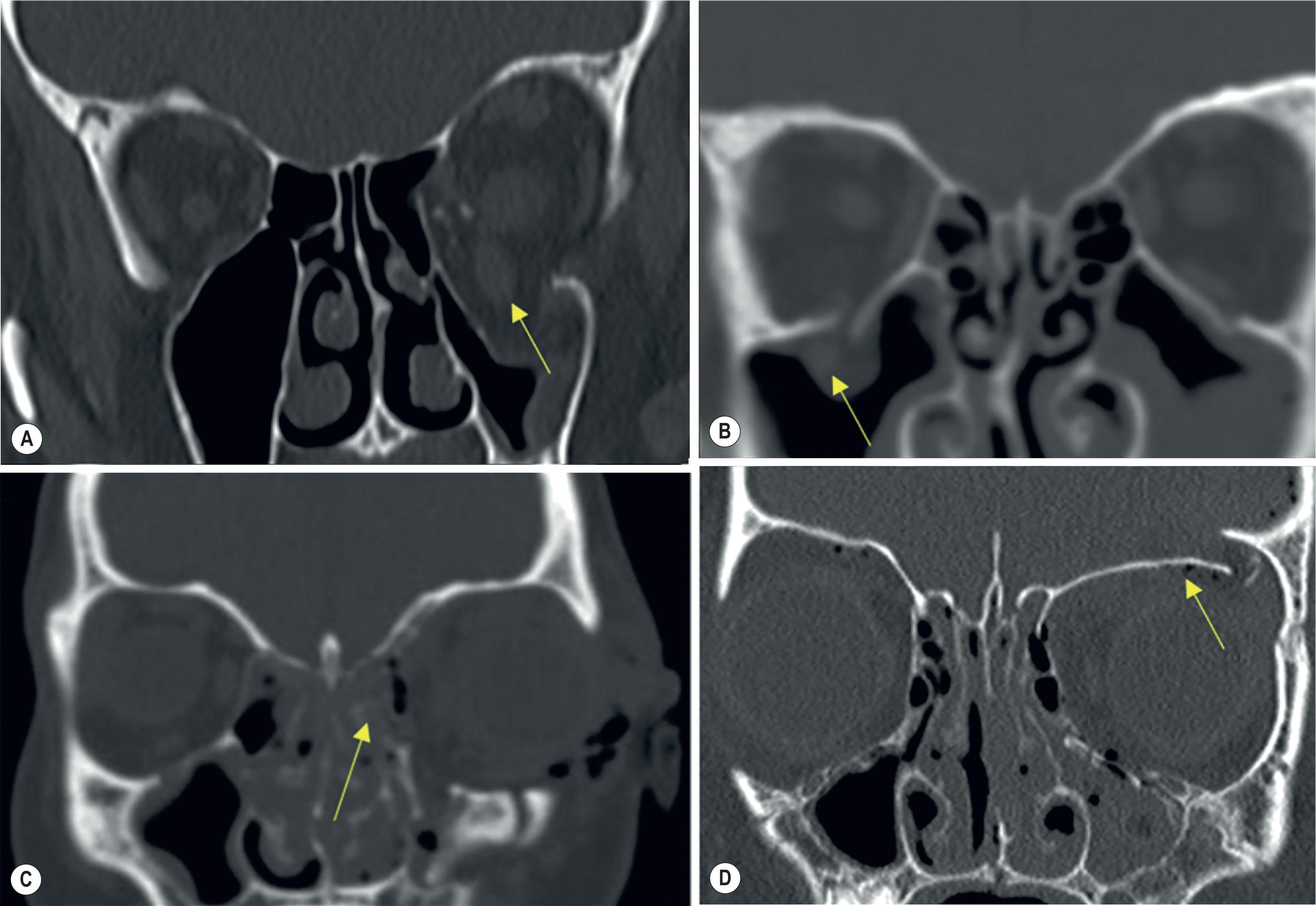
“Trapdoor” fracture ( Fig. 1.16B ): In children, force transmitted along the orbital floor may result in a temporary buckling of the bony framework, with an instantaneous fracture and “scissoring” of the inferior rectus muscle within the fracture site. The subsequent recoil of the bone to its original position results in incarceration of the soft tissue outside of the orbit, frequently with no other radiographic evidence of bony disruption. Clinical examination in these patients may demonstrate impaired upward gaze with associated nausea/vomiting or oculocardiac reflex (nausea, bradycardia, hypotension). Entrapped muscle requires urgent management (ideally within 8 hours from injury) to prevent irreversible muscle ischemia and resultant fibrosis.
Medial wall fracture ( Fig. 1.16C ): Fracture of the medial orbital wall may occur in isolation or in association with other orbital wall fractures, most commonly the floor. When medial wall fractures occur in conjunction with orbital floor fractures disruption of the inferomedial orbital strut (“inferomedial bulge”) will result in loss of globe projection. Management of these types of injuries is predicated on accurate reconstruction of the inferomedial prominence to reproduce the posteromedial support for the globe.
“Blow-in” fracture ( Fig. 1.16D ): A blow-in fracture is one in which the orbital wall is displaced inwardly, resulting in a decrease in orbital volume. Blow-in fractures typically involve the orbital roof and lateral orbital wall.
The goals of surgical management of orbital fractures are to: (1) release entrapped soft-tissue structures and restore normal ocular mobility; (2) reposition displaced orbital soft tissues to their normal locations; and (3) restore orbital volume and shape to maintain normal globe projection.
Patients with documented extraocular muscle entrapment with concern for muscle ischemia should be managed acutely (i.e., within 8 hours of injury). All other patients may be managed in a sub-acute manner. In particular, the presence of significant periorbital edema may make determination of globe position difficult and impede surgical access. In patients with significant edema, retrobulbar hemorrhage, and globe injuries such as hyphema, and unclear visual prognosis, surgical intervention can be deferred.
In this context, the clinician must balance the need to safely access the internal orbit with the potential for improved outcomes with early management (i.e., before scarring and fibrosis have occurred). Significant injuries to the orbit are best managed in the early post-injury period (i.e., within 7–10 days). In the authors’ opinion, for patients with significant orbital volume change, the earlier the correction is accomplished, the better the final functional and aesthetic result.
Operative approaches for orbital fractures can be broadly categorized as endoscopic, cutaneous, or mucosal.
Endoscopic approach: Minimally invasive approaches to managing orbital floor and medial wall fractures using an endoscope have gained popularity over the past 20 years. Trans-antral approaches to the orbital floor allow for visualization of the herniated orbital contents from inferiorly, along with their reduction. This approach comes with the benefit of avoiding a transcutaneous or mucosal incision. However, placement of reconstructive materials may be challenging with this approach.
Transcutaneous approach: Transcutaneous approaches to the orbital floor include the subciliary, subtarsal (mid-lid), and infraorbital rim approaches. The subcililary approach, which is typically placed within 2–3 mm of the lower eyelash line, tends to leave the most inconspicuous scar, but has the highest incidence of lower eyelid retraction (ectropion and scleral show). The mid-lid approach is accomplished using an incision placed 5–8 mm below the lid margin (below the level of the pretarsal orbicularis muscle) and results in less ectropion but may result in a most obvious scar if carried lateral to the lateral limbus. The infraorbital rim approach utilizes an incision at the lid–cheek junction and affords broad access with a low risk of lower eyelid malposition but comes at the expense of a frequently noticeable scar and potential for lymphedema.
Transmucosal approach: The transmucosal approach to the orbital walls utilizes incisions through the conjunctiva. For access to the orbital floor, these incisions may be carried through the orbital septum (pre-septal) or along the posterior surface of the septum (post-septal). Access to the medial wall can be achieved with a trans- or retrocaruncular extension. Access to the lateral orbital can be facilitated with the addition of a lateral canthotomy. These incisions carry the advantage of avoiding a cutaneous scar (unless a canthotomy is utilized) but the risk of scarring that shortens the posterior lamella, resulting in entropion.
The authors’ preferred approach is to utilize a transconjunctival approach for management of isolated orbital floor/medial wall fractures and a mid-lid approach when access to the infraorbital rim is necessary (e.g., for management of orbital floor fractures with associated zygomaticomaxillary complex [ZMC] or NOE fractures).
Preoperatively, the pupils are checked for symmetry and reactivity and extraocular movements are evaluated and documented. Once the patient is placed under general anesthesia, forced ductions can be performed to assess for ocular motility followed by placement of a lubricated corneal protector over the eye. The orbit is accessed through a transcutaneous or transconjunctival approach and the external rim is identified. Dissection is then carried posteriorly until the intact orbital margins surrounding the fracture (e.g., anterior, medial, lateral, and posterior for orbital floor fractures) are clearly identified. The posterior ledge, which frequently involves the orbital process of the palatine bone (typically located 35–38 mm posterior to the infraorbital rim), is often the most difficulty to identify. This can be simplified by placing a small periosteal elevator (e.g., Woodson or Freer) into the maxillary sinus and walking the instrument up the posterior sinus wall until the posterior ledge of the orbital floor fracture is felt (this distance may be easily verified by measuring along the defect on a CT scan). Once the boundaries of the fracture are defined, the soft tissue associated with the fracture is then carefully dissected free of the fracture (this may require enlarging the fracture) and reduced into the orbit. The reconstituted soft-tissue morphology is then supported by a rigid material such as titanium mesh, porous polyethylene, or autologous bone graft, to reconstruct the orbital wall defect ( Fig. 1.17 ). More recently, 3D anatomic orbital implants have become availbale, which are useful for combined orbital floor and medial wall fractures ( Fig. 1.18 ). Forced ductions are then repeated to ensure that there is no restriction of ocular motility. Intra-operative navigation or intra-operative CT may be used to confirm the appropriate placement of the implant.

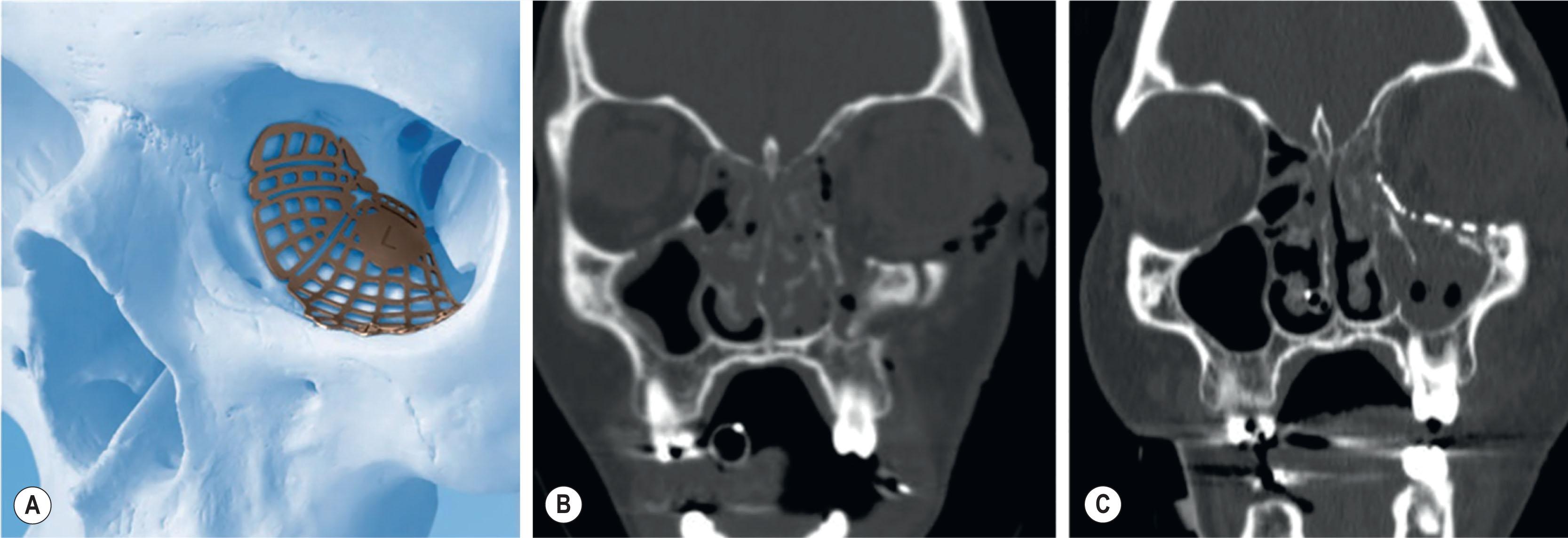
Light perception and visual acuity are assessed every 1–2 hours for the first 24 hours after surgery and then twice daily for the first few days after surgery. It is not uncommon for patients to have diplopia with vertical or lateral movements immediately after surgery, due to intra-orbital swelling. Careful blood pressure control during extubation and in the immediate postoperative period is necessary to prevent intra-orbital hemorrhage. Patients should abstain from strenuous activities and heavy lifting until 4 weeks postoperatively.
Complications in patients with orbital fractures include alterations in visual acuity, globe movement, or globe position.
Ocular injuries occur in up to 30% of patients with orbital fractures and may range from minor injuries such as corneal abrasions, to major injuries such as globe rupture. One of the most dreaded sequelae of orbital injuries or their management is blindness, which is, fortunately, infrequent. The incidence of acute vision loss associated with facial injury is approximately 1–2%. Blindness following management of facial fractures is an order of magnitude lower, at 0.2%.
Diplopia following orbital fractures is the result of imbalance between extraocular muscle pull on the globe. In the acute traumatic or postoperative setting, this may be the result of nerve injury (cranial nerves III, IV, or VI), muscle injury, entrapment, or swelling/contusion.
Globe retroposition, or enophthalmos, is the result of orbital volume expansion with associated soft-tissue herniation, resulting in a change in shape of the orbit from conical to spherical. While initially believed to be related to soft tissue atrophy, high-resolution imaging studies have demonstrated that loss of globe projection from bony volume expansion is the main contributing factor to enophthalmos. Discrepancy in sagittal position of the globes of >2 mm is clinically significant.
Spontaneous proptosis may occur in the setting of recurrent retrobulbar hemorrhage, longstanding low-grade infection around implanted materials, or from chronic sinus or lacrimal system obstruction/infection.
Retrobulbar hematoma frequently arises from disruption of veins within the posterior orbit and presents clinically as proptosis or exophthalmos with associated prolapse of the conjunctiva. Acute retrobulbar hemorrhage with increased intraocular pressure can be addressed in part with lateral canthotomy and lateral cantholysis. Retrobulbar hemorrhage identified on CT scan without increased intraocular pressure or vision changes may be managed expectantly. Of note, orbital reconstruction in the setting of retrobulbar hemorrhage may carry an increased risk of complications due to altered circulation to the globe. Subacute management of these patients, after resolution of hemorrhage, swelling, and congestion, and stabilization of vision, is recommended.
Eyelid malposition may be related to the acute injury, with proptosis resulting in an altered relationship between the corneal surface and eyelid lamellae, or from surgical approaches to the orbit. With retropositioning of the globe, the upper eyelid may appear ptotic (pseudoptosis); true ptosis, related to loss of levator palpebrae superioris function, is uncommon following orbital injuries. Ptosis in the setting of enophthalmos should not be treated until the enophthalmos is addressed.
Eyelid malposition may also be the result of altered position of the infraorbital rim or shortening of the lower eyelid soft tissues. The orbital septum and lower eyelid are fixed to the infraorbital rim. Posterior or inferior displacement of the infraorbital rim will result in inferior pull of the lower eyelid, with concomitant change in the margin–reflex distance and increased scleral show. Eyelid malposition related to surgical approaches is the effect of scarring that shortens either the anterior lamella (skin and orbicularis muscle), resulting in ectropion, or posterior lamella (conjunctiva, septum, lower lid retractors), resulting in entropion. Meticulous dissection and reapproximation of soft tissues is the most effective method of avoiding these problems. Secondary procedures to elevate the eyelid generally do not afford correction beyond 3 mm.
Infraorbital nerve (V 2 ) dysfunction is frequently encountered in patients with orbital floor fractures, given the course of the infraorbital nerve along the undersurface of the orbital floor. In the acute setting, patients may complain of altered sensation in the ipsilateral lower eyelid, cheek, lateral nasal skin, upper lip, and upper teeth/gums. Decompression of the nerve with repositioning of the bony segments may help improve sensibility. Patients should be counseled that altered sensibility from injury may take up to 18 months to improve and may never completely resolve.
Orbital fractures that extend into the posterior third of the orbit may involve the superior orbital fissure or orbital apex. Superior orbital fissure syndrome is characterized by ophthalmoplegia related to the altered function of cranial nerves III (oculomotor), IV (trochlear), and VI (abducens), and corneal anesthesia from injury to the ophthalmic division of the trigeminal nerve( V1), all of which transit through the superior fissure. Involvement of the oculomotor nerve will result in paralysis of the levator muscle (ptosis) as well as impaired ocular movement due to paralysis of the inferior rectus, inferior oblique, superior rectus, and medial rectus muscles. Trochlear nerve injury will be manifest as loss of superior oblique function; abducens nerve injury will present as paralysis of lateral rectus function. Orbital apex syndrome occurs when superior orbital fissure syndrome is accompanied by vision changes suggestive of optic nerve (CN II) involvement.
Become a Clinical Tree membership for Full access and enjoy Unlimited articles
If you are a member. Log in here